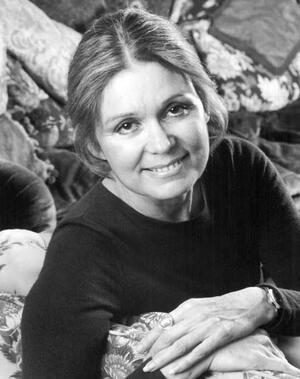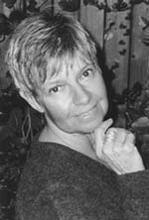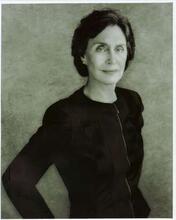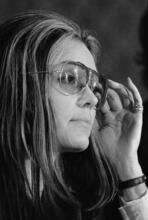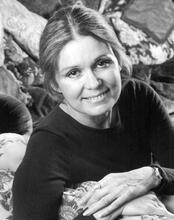Gloria Steinem
Gloria Steinem, who exemplifies the Second Wave of American Feminism, began her career as a journalist writing under a man's name. She went on to co-found Ms., the first feminist periodical with a national readership. An advocacy journalist, she writes passionately about issues of women's empowerment and gender, racial and economic equality.
Courtesy of Sylvia Edwards, Longview Community College
A leader of second-wave feminism, Gloria Steinem has worked tirelessly all her life as an advocate for change. Steinem identifies with Jewishness insofar as she considers herself to be an outsider and Jews to be the quintessential out-group. As a journalist during the 1960s, Steinem’s coverage of a public hearing on abortion was the turning point which propelled her towards the women’s movement. In 1969 she became a true spokesperson for the feminist movement, talking on campuses and at street rallies and explaining the shared origins of race and gender caste systems; Steinem mobilized a generation of women to advance the cause of women’s liberation. In 1971 she co-founded Ms. Magazine, the first feminist periodical with a national readership. Steinem has co-founded several organizations, published many books, and involved herself in numerous political campaigns.
Why Is Gloria Steinem in a Jewish Women’s Encyclopedia?
She was born to a rebellious Scotch Presbyterian mother, raised in Theosophy, and baptized in a Congregational church at the age of ten because her mother thought she should be old enough to remember it. She lost what little interest she had in religion when she became a feminist and started “wondering why God always looks like the ruling class,” but she still loves the pagan parts of Christmas—the tree, presents, and midnight Mass. With all this, what is Gloria Steinem doing in a Jewish women’s encyclopedia?
She is included here because her father was a Jew, because she considers herself an outsider and sees Jews as the quintessential out-group, and because she feels drawn to the spirituality and social justice agenda of Jewish feminism. She is here because, as she puts it, “Never in my life have I identified myself as a Christian, but wherever there is antisemitism, I identify as a Jew.” Finally, she is here because in the eyes of the world she is Jewish, and thus whatever she does is associated with Jews and Judaism, for good or for ill.
When historians distill the essence of the women’s movement known as the Second Wave (as opposed to the suffrage campaign, the First Wave), they often embody it in two names—Betty Friedan and Gloria Steinem—both ground-breaking pioneers, both identified as Jews. By the same token, when extremists of the ultra-right excoriate feminism, they name Steinem (along with Friedan and former Congresswoman Bella Abzug) as a leader of the “Jewish conspiracy” to destroy the Christian family. They claim that the struggle for abortion rights is a Jewish plot to kill Christian babies, or that empowering children, women and minorities is a threat to the God-given hegemony of white Christian men. If Steinem is their Jew, she is ours.
Although she is recognized around the world as a writer, speaker, political activist, and feminist visionary, the facts about Gloria Steinem’s Jewish origins, tenuous and meager though they may be, are virtually unknown. To recognize those connections here is not to exaggerate their significance but merely to acknowledge the unacknowledged and to suggest that even without full-fledged Jewish identity—one forged by affiliation or The legal corpus of Jewish laws and observances as prescribed in the Torah and interpreted by rabbinic authorities, beginning with those of the Mishnah and Talmud. halakhic legitimacy (religious law)—this is a woman who acts Jewishly in the world.
Early Life & Family
Gloria Steinem was born on March 25, 1934, in Toledo, Ohio, to Ruth and Leo Steinem. Her father, an itinerant antique dealer, spent winters selling his wares from a house trailer, usually with his family in tow; as a result, Gloria did not spend a full year in school until she was twelve years old. In the summers, Leo owned and operated a beach resort at Clark Lake, Michigan, where little Gloria apprenticed herself to the nightclub entertainers and learned to tap-dance.
Steinem’s appreciation of Judaism, such as it was, came at the hands of her non-Jewish mother. A former journalist, Ruth Steinem took some pains to make sure both Gloria and her older sister, Susanne, understood the evils of antisemitism and knew about the horrific crimes of the Holocaust. Steinem remembers that when she was eight or so, her mother encouraged her to listen to a radio dramatization of Jewish torment under the Nazis and the story of a mother who could not get enough food for her little girl. “This is going on in the world,” Ruth Steinem said, “and we must know about it.” She also taught her daughters that being Jewish was a proud heritage.
Pauline Perlmutter Steinem, Gloria’s paternal grandmother, was born in Germany after her family’s escape from Russia and grew up in Munich, the daughter of a cantor. She achieved the equivalent of a college education in order to become a teacher, then married Joseph Steinem and immigrated to America. Pauline Steinem died when Gloria was five, but she left her granddaughter with vivid “sense memories” of an intelligent, calm, well-organized woman who remains a strong role model. A well-known women’s rights activist, chair of the educational committee of the National Woman Suffrage Association, a delegate to the 1908 International Council of Women, and the first woman to be elected to the Toledo Board of Education, Pauline Steinem was also a leader in the movement for vocational education. She was deeply distressed by the gathering storm clouds in Germany. In the mid-1930s, during the early years of the Nazi terror, when it cost five hundred dollars to get a Jew out of Germany and into Palestine, Pauline Steinem managed to rescue many members of her family.
Despite having the benefits of a hard-won education at the University of Toledo and a career as a journalist at a time when she first had to write under a man’s name, Ruth Steinem’s spirit was broken by the conflict between work and family that caused her to give up the career she loved. In response to this and other strains, she suffered incapacitating depressions and hallucinations. She and Leo divorced in 1945, and eleven-year-old Gloria became housekeeper, cook, and caregiver to her mother during a period that, at best, can be called cheerless and at worst, spiritually and financially impoverished. In her early teens, Gloria performed at local clubs for ten dollars a night, hoping to tap-dance her way out of Toledo. When she was sixteen, she worked as a salesgirl after school and on Saturdays. The following year, she was rescued by Susanne, who persuaded their father, despite the divorce, to take over Ruth’s care for one year so that Gloria could get away and live with her sister in Washington, D.C.
Initial Career
In 1952, after graduating from Washington’s Western High School, Steinem entered Smith College, where she danced in college productions and majored in government. She spent her junior year in Geneva and a summer in Oxford, earned a Phi Beta Kappa key, and graduated magna cum laude. A Chester Bowles Fellowship sent her to India, where for nearly two years she immersed herself in the culture of a people she grew to love and would often write about, first in a government guidebook, The 1000 Indias, and later in essays on the relevance of Gandhian principles to grassroots organizing, especially for the women’s movement.
Back in the United States in 1958, she moved to Cambridge, Massachusetts, and worked for Independent Research Service, a group that tried to persuade American students to attend communist youth festivals then being held in Europe. Hoping for a career as a writer, she moved to New York City in 1960, a time when women were expected to be Gal Fridays and gossip columnists, not serious journalists. She managed to cobble a modest living from odd scraps of assignments—working with Harvey Kurtzman, creator of Mad magazine, on his new project, Help!, a journal of political satire, and contributing short articles to Glamour, Ladies’ Home Journal, and other women’s magazines. She also did unsigned pieces for Esquire, which eventually published her first bylined piece, a story about the then-new contraceptive pill. A year later, in 1963, Steinem herself made headlines when she got an assignment from Show magazine for which she took a job as a Bunny at the Playboy Club and wrote an exposé of the unglamorous working conditions of the club’s glorified waitresses—sex objects in rabbit ears and cotton tails.
Regardless of her new celebrity and proven investigative skills, Steinem could not persuade editors to let her cover the political subjects that interested her. Still, rather than be relegated to the girl ghettos of food and fashion, she got as far as writing profiles of people such as Truman Capote and James Baldwin. Simultaneously, she volunteered with Cesar Chavez’s United Farm Workers and Robert F. Kennedy’s presidential campaign, experiences that amounted to a hands-on political education.
A Spokesperson for the Women’s Movement
In 1968, she became a founding editor of New York magazine, where she was finally able to graft her writing to her political interests in a column that established her as a voice for the voiceless and a force for change. Suddenly the magazine gave her other assignments—political profiles, coverage of the 1968 presidential campaign, the New York City mayoral race, the civil rights, antiwar and migrant workers’ movements, the first moon landing—and with them came the long-awaited satisfaction of being taken seriously. But it was a public hearing on abortion, then illegal in the United States, that radicalized Steinem’s perception of what makes an issue “serious.” Covering this event made her question why women’s lives are rarely considered important enough for media attention and public discourse. It also led her to research the fledgling feminist movement and discover that feminism made sense of her own life.
In 1969, she began what would become a second career as a spokesperson for the women’s movement. Often pairing herself with one of her African-American friends—usually Dorothy Pitman Hughes, Flo Kennedy, or Margaret Sloan—Steinem talked on campuses, in community centers, union halls, and corporate boardrooms, at sit-ins and street rallies. She talked about the shared origins of race and gender caste systems, how the cultural equation of masculinity with dominance feeds the roots of violence, how sex rules stunt the development of children and suffocate the aspirations of both women and men. She touched women’s hearts, blew their minds, and mobilized them to start consciousness-raising groups, lawsuits, legislative strategies, and social change organizations to advance the cause of women’s liberation. Generally speaking in those years, her analysis of shared oppression did not extend to the experience of the Jewish people, nor did she then, as she would later, make the analytical connection among sexism, racism, and antisemitism.
Ms. Magazine & Other Publications
In 1971, she cofounded Ms.—the magazine that roared—the first feminist periodical with a national readership and the first mass-market women’s magazine with a revolutionary agenda. In the decades since, her writing has appeared in innumerable magazines, newspapers, anthologies, television commentaries, political campaigns, and film documentaries in America and internationally. She has been the subject of many media profiles and has appeared on the cover of Newsweek, McCalls, People, New Woman, Ms.,,and Parade.
Never again a pen for hire, she has become a brilliant advocacy journalist whose definition of objectivity includes the overt promotion of justice and whose pursuit of truth is aided, not compromised, by her empathy for the oppressed. What she writes about is what she believes in—women’s empowerment and feminist solidarity, racial and economic equality, reproductive freedom, nonsexist child rearing, multicultural education, stopping violence, especially the sexual abuse of women and children, and more recently, preserving the cultures of indigenous peoples and disseminating their lessons of gender balance and balance of nature.
The titles of her books suggest both the evolution of her ideology and her state of mind at the time each was written. Outrageous Acts and Everyday Rebellions (1983) is a collection of twenty years of her most enduring, powerfully argued essays, from the Playboy Bunny story to her satirical classic, “If Men Could Menstruate”; from her probing interviews of Patricia Nixon and Jacqueline Kennedy Onassis to the searingly confessional “Ruth’s Song,” a tribute to her mother. Marilyn: Norma Jean (1986) is a warm, sympathetic rendering of the life of Marilyn Monroe, revisited from the perspective of feminist analysis. Revolution From Within: A Book of Self-Esteem (1992) describes Steinem’s efforts to link internal and external change into a full circle of revolution, partly through a reconsideration of her childhood and the inner life that she had repressed in her lifelong effort to be “useful to people in the outside world”—first her mother, then all of womankind and every other marginalized group. Moving Beyond Words (1994), an idiosyncratic compendium of original and previously published works, ranges from a scathing send-up of Freud to a paean to women muscle builders; from an exposé of the censoring power of advertisers to her epiphanies at turning age sixty.
Political Involvements
Not content to limit herself to words when action is called for, Steinem has been an indefatigable fund-raiser for women’s causes and the cofounder of several still-thriving organizations: the Women’s Action Alliance (1971), the first national clearinghouse for information and technical assistance on women’s issues and projects; the National Women’s Political Caucus (1971), a bipartisan organization devoted to getting pro-equity women into elected and appointed office; the Ms. Foundation for Women (1972), which was originally founded to channel the (nonexistent) profits of Ms. magazine into women’s activities, and which now raises and distributes funds for grassroots projects that empower women and girls; the Coalition of Labor Union Women (1974), a national group devoted to equalizing women’s position in the labor movement; and Voters for Choice (1979), a bipartisan political action committee that supports candidates pledged to protect reproductive freedom.
She has played a major role—as speaker, delegate, organizer, commissioner, journalist, or scribe—at many important public events, among them many Democratic conventions after 1968, a conference of journalists at the United Nations Women’s Conference in 1975 in Mexico City, and the 1977 National Women’s Conference convened by Congresswoman Bella Abzug and others as a kind of Constitutional Convention for Women. She has also been involved in innumerable electoral campaigns, most notably the presidential bids of Robert F. Kennedy, George McGovern, Shirley Chisholm, and Walter Mondale and his running mate Geraldine Ferraro, as well as the congressional campaigns of Colorado representative Patricia Schroeder, Maryland senator Barbara Mikulski, Texas governor Ann Richards, and Illinois senator Carol Mosley-Braun. She joined Betty Friedan in Washington D.C. for the “March for Women’s Lives,” a mass rally to “voice opposition to government attacks” on women’s reproductive rights, in April 2004.
Jewish Connections
Steinem does have at least one meaningful current Jewish connection. Every A seven-day festival to commemorate the Exodus from Egypt (eight days outside Israel) beginning on the 15th day of the Hebrew month of Nissan. Also called the "Festival of Mazzot"; the "Festival of Spring"; Pesah.Passover for over twenty years, she has joined a small group of “Lit. "order." The regimen of rituals, songs and textual readings performed in a specific order on the first two nights (in Israel, on the first night) of Passover.sedersisters”—E. M. Broner, Phyllis Chesler, Lilly Rivlin, Michelle Landsberg, Bea Kreloff, Edith Isaac-Rose, and Letty Cottin Pogrebin—Jewish women in New York City who plan and perform a women’s seder, usually on the third night of Passover. The founding premise of this seder is that women matter, that women must be acknowledged for their roles in the Exodus story and their current struggle for equality in Jewish life. Using traditional ritual objects and a nontraditionalist The "guide" to the Passover seder containing the Biblical and Talmudic texts read at the seder, as well as its traditional regimen of ritual performances.Haggadah
written by Broner and Naomi Nimrod, the group, led first by Chesler and then by Broner, also draws upon poetry, song, prayer, and personal testimony to honor Jewish women and make room for female expressions of spirituality that have been ignored or eclipsed by traditional man-made, male-led ceremonies. Over the years, Steinem has sung “Dayenu” and “Miriam ha-Nevi’ah” [Miriam the Prophet], shared in discussions of “The Ten Plagues of Women” and “The Four Questions of Women,” and helped to make modern A type of non-halakhic literary activitiy of the Rabbis for interpreting non-legal material according to special principles of interpretation (hermeneutical rules).midrash about our Jewish foremothers.
Of her participation in this unique revisionist tradition, Steinem says: “The women’s seder introduced me to ritual. It was the first spiritually-centered occasion in my feminist life. Other feminist gatherings had a consciousness-raising component but it was more about the politics of the here and now; it didn’t admit of the past or one’s spiritual needs. When I feel most drawn to Judaism it’s not the law part that attracts me, it’s the mystical part, the The esoteric and mystical teachings of JudaismKabbalah, the Shechinah [female aspect of God]. I do feel socially drawn to Jewish warmth, sensuality, expressiveness.”
Not long ago, Steinem’s sister, Susanne, a gemologist, came across a catalog listing items of jewelry that belonged to victims of the Nazis, items that were auctioned to aid Jewish survivors when no one could locate the original owners or their heirs. Today, that catalog rests in the library of the Holocaust Memorial Museum in Washington, D.C. Its bookplate reads: “Donated in honor of Pauline Perlmutter Steinem by Susanne Steinem Patch and Gloria Steinem.”
Personal Life
Gloria Steinem married David Bale on September 3, 2000. “Though I’ve worked many years to make marriage more equal, I never expected to take advantage of it myself,” said the sixty-six-year-old Steinem, who in earlier years had spoken out in opposition to the institution of marriage. “I’m happy, surprised and one day will write about it, but for now, I hope this proves what feminists have always said—that feminism is about the ability to choose what’s right at each time of our lives.” Bale died in January 2004.
Watch video clips of an interview with Gloria Steinem from the MAKERS project.
Selected Works
Outrageous Acts and Everyday Rebellions. 3rd ed. New York: Picador, 2019.
With George Barris Marilyn: Normal Jean. New York: Henry Holt and Company, 1986.
Revolution From Within: A Book of Self-Esteem. 2nd ed. New York: Open Road Integrated Media, 2012.
Moving Beyond Words. New York: Simon & Schuster, 1994.
The Truth Will Set You Free, But First It Will Piss You Off! Thoughts on Life, Love, and Rebellion. New York: Random House, 2019.
My Life on the Road. New York: Random House, 2016.
As If Women Matter: The Essential Gloria Steinem Reader. Edited by Ruchira Gupta. New Delhi: Rupa Publications India Pvt. Ltd., 2014.
Dow, Bonnie J. “After 1970: Second-Wave Feminism, Mediated Popular Memory, and Gloria Steinem.” In Watching Women’s Liberation, 1970: Feminism’s Pivotal Year on the Network News, 168-200. Urbana, Chicago, and Springfield: University of Illinois Press, 2014.
Gloria: In Her Own Words. Directed by Peter Kunhardt. HBO, 2011.
Heilbrun, Carolyn G. The Education of a Woman: The Life of Gloria Steinem. New York: Ballantine Books, 1995.
Steinem, Gloria, Meenakshi Mukherjee and Ira Pande. “A Conversation with Gloria Steinem.” India International Centre Quarterly 34, no. 2 (Autumn 2007): 90-105.
Steinem, Gloria and Ruchira Gupta. “Trafficking Sex: Politics, Policy, Personhood: A Conversation with Gloria Steinem and Ruchira Gupta.” Meridians 12, no. 1 (2014): 172-200.
Thom, Mary. Inside Ms: 25 Years of the Magazine and the Feminist Movement. New York: Henry Holt & Co., 1997.
Tillet, Salamishah. “Why Ruth Bader Ginsburg and Gloria Steinem Still Matter.” Signs: Journal of Women in Culture & Society 42, no. 3 (Spring 2017): 790-792.

